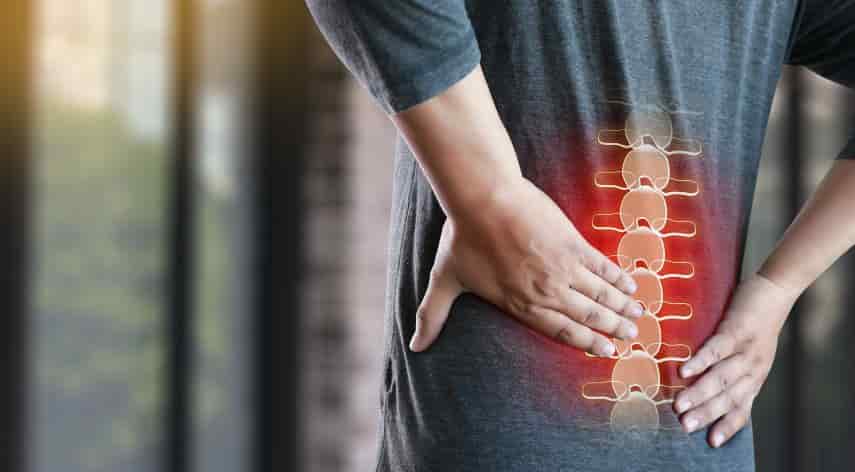Lower Back Pain and its Causes and Treatment

Do you feel some discomfort and pain your back sometimes? It is lower back pain. Back pain especially in lower side can happen because of a number of causes including underlying diseases, internal organs, spinal nerves, discs, bones and muscles. Directly or indirectly these cause back pain in lower side.
The most common cause of back pain results from minor problems such as misaligned spine and pulled muscle. Even it points towards urgent conditions such as spinal stenosis and kidney stones.
When it frustrates you, it is important to note that lower back pain is not a major problem. It is treatable from the comfort of home only. But ongoing as well as severe pain must need to evaluate by the doctor.
Read on this blog to know about its potential causes and the effective treatment options.
Table of Contents
ToggleLower right back pain causes
Most of the time lower back pain occurs because of muscles and bones moving down the spinal column. Neurological causes can happen due to lumbar nerve roots. Some rare and underlying conditions will lead to right-sided back pain too. That means you have pain in lower back but the original problem is somewhere else. Here is the list of some conditions which cause lower back pain.
Kidney stones
This can cause non-spine-associated back pain. When it passes through the urinary tract it causes excruciating pain. Because of kidneys’ location in the body, you will feel deep pain in right or left side of back. The pain is quite sharp and you may experience vomiting, nausea, painful urination and lower abdominal pain at the same time.
Gallstones
It can lead to pain in right side of back because of the gall bladder which located below liver. Additionally, gallstones will lead to intense and sudden pain in upper abdomen just below the ribcage, in right shoulder and between shoulder blades. Patients also experience vomiting and nausea at the same time.
Herniated disc
This condition takes place if the shock-absorbing cushion within two consecutive vertebrae ruptures or bulges. In several cases, the liquid substance into the disc starts leaking out.
If it comes into contact of nerve root then it leads to short circuiting the electrical signals in the body. Therefore, you will start experiencing radiculopathy and its symptoms.
Although it doesn’t deem for surgery yet only 10% of it doesn’t improve with just non-surgical treatment. Physical therapy is essential for disc herniations and you may need 6-week therapy course too.
Bone spurs and arthritis
These are interconnecting joints you can find at back of spine. Altogether, they provide integrity to the spine with limited spinal movement. Each one of them has left and right facet joint. It is the place where development of bone spurs takes place and abnormal growths can happen because of previous trauma, arthritis and lots more.
But if it develops on right facet joint then it will lead to right-sided pain. So, you will encounter electrical sensations shooting down the leg, tingling, numbness and leg weakness.
Spinal stenosis
It happens if the spaces within spinal vertebrae narrows down and leads to pressure on nerve roots and spinal cords. If it takes place in lumbar spine you will experience lower right back pain on both or either of the sides. Pain due to spinal stenosis will give you burning sensation. It will spread from buttocks to legs.
Spinal stenosis pain will worsen down during walking or standing and will give you relief with leaning forward. You can also experience cramping, weakness, tingling and numbness in legs and feet. When you walk or stand the symptoms are more prominent.
Sacroiliac joint disorders
This joint links the pelvis to sacrum and it refers to triangular bone within tailbone and lower spine. The abnormal movement or locking of these joints because of trauma and other causes can result in back pain along with referred pain.
It also causes because of an arthritis form namely ankylosing spondylitis. It refers to the debilitating and gradual disease which can fuse the parts of spine together. That’s why you will start experiencing immobility, pain and spinal stiffness.
Scoliosis
This is spine’s abnormal curvature which leads to “C” or “S” shape. It makes the muscle overstretched and tight in a section and compressed on other. It mostly takes place in adults and unilateral. Moreover, muscle spasms and sciatica are quite similar.
Spinal tumours and cysts
Tumours and spinal cysts are two potential causes of lower back pain. Cysts can form because of degenerative changes in spine and tumours form because of cellular changes. The cyst will press the nerve root which transfers to other body parts. As a result, it leads to nerve pain namely radiculopathy.
At that time you will experience pins-and needles like sensation, numbness, weakness and pain throughout a leg. You may feel discomfort and cramping at the time of walking too.
Spinal tumours, on the other hand, can be either malign or non-malign. Symptoms comprise of back pain which will spread to other parts. Bladder or bowel incontinence, reduced sensitivity to severe pain, difficulty walking and muscle weakness can happen as well.
Cauda equina syndrome
It is rare as well as severe condition, which takes place when the nerve roots in lumbar spine compresses. As a result, it disrupts the normal functioning of legs, bowel and bladder. Some of its causes are spinal birth defects, infections, tumours and spinal trauma.
You can experience severe lower right back pain, loss of reflexes in legs, sexual dysfunction, bowel incontinence, unable to pee, leg numbness and sciatica. It requires immediate surgery.
Diagnosis
Diagnosis of lower back pain in right side comprises of physical assessment along with review of the medical history. It may include neurological exam to determine if the reflexes are in normal condition or there is some sensation or weakness indicating to nerve injury.
Depending on the report, the doctor will suggest some imaging studies to check the spine abnormality. It involves X-ray of spine along with CT (computed tomography) scan. MRI or magnetic resonance imaging is able to detect the soft tissue damage in much better way.
You may also need nerve conduction study that lets the doctor to check the flow of electrical signals through nerves.
Treatment
Treatment of lower right back pain differs on the basis of underlying cause. In case, it is happen because of systemic illness then that needs to resolve firstly.
Some effective treatment options for lower right back pain are:
- Surgery
- Epidural steroid injections
- Chiropractic and osteopathic manipulation
- Physical therapy
- Prescription opioid drugs
- Nonsteroidal anti-inflammatory drugs (NSAIDs)
Conclusion
Lower right back pain can happen because of nerve-, bone- and muscle-related issues affecting your spine. It comprises of the above-mentioned causes. Sometimes other problems such as gallstones and kidney stones also lead to lower back pain. For diagnose and treatment of your treatment of lower back pain doctor needs to review your medical history and physical exam.
Alfred Williams, a distinguished business writer, navigates the corporate landscape with finesse. His articles offer invaluable insights into the dynamic world of business. Alfred's expertise shines, providing readers with a trustworthy guide through the complexities of modern commerce.
Recommended For You
Spread the loveThe name Broderick Bevineau makes you think of new ideas and starting your own business. Bevineau has made
Spread the loveThe popularity of Airbnb has paved the way for many entrepreneurs to build businesses in the short-term rental
Spread the loveCreating a well-designed and functional website starts long before coding begins. The prototyping phase is a critical step





